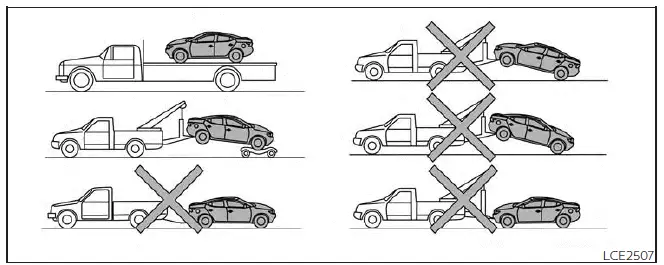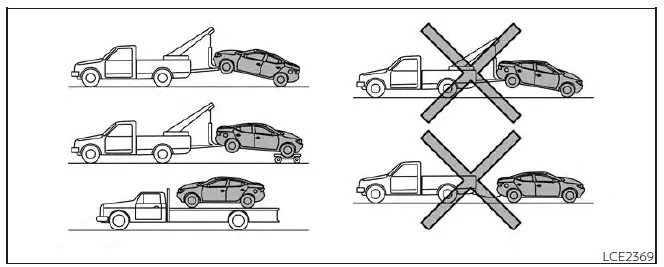Nissan Altima (L34) 2019-2025 Owners Manual: Towing your vehicle
When towing your vehicle, all State (Provincial in Canada) and local regulations for towing must be followed. Incorrect towing equipment could damage your vehicle.
Towing instructions are available from a NISSAN dealer. Local service operators are generally familiar with the applicable laws and procedures for towing. To assure proper towing and to prevent accidental damage to your vehicle, NISSAN recommends having a service operator tow your vehicle. It is advisable to have the service operator carefully read the following precautions:
WARNING
- Never ride in a vehicle that is being towed.
- Never get under your vehicle after it has been lifted by a tow truck.
CAUTION
- When towing, make sure that the
transmission, axles, steering system
and powertrain are in working condition.
If any of these conditions apply, dollies or a flatbed tow truck must be used.
- Always attach safety chains before towing.
For additional information about towing your vehicle behind a Recreational Vehicle (RV), see "Flat towing".
Towing recommended by NISSAN
NISSAN recommends towing your vehicle based upon the type of drivetrain. For additional information, refer to the diagrams in this section to ensure that your vehicle is properly towed.

All-Wheel Drive (AWD) models with Continuously Variable Transmission (CVT)
NISSAN recommends that towing dollies be used when towing your vehicle or place the vehicle on a flatbed truck as illustrated.
CAUTION
Never tow All-Wheel Drive (AWD) models equipped with a Continuously Variable Transmission (CVT) with any of the wheels on the ground as this may cause serious and expensive damage to the powertrain.

Two-Wheel Drive models with Continuously Variable Transmission (CVT)
NISSAN recommends that your vehicle be towed with the driving (front) wheels off the ground or place the vehicle on a flatbed truck as illustrated.
CAUTION
- Never tow Continuously Variable
Transmission (CVT) models with the
front wheels on the ground or four
wheels on the ground (forward or
backward), as this may cause serious
and expensive damage to the transmission.
If it is necessary to tow the vehicle with the rear wheels raised always use towing dollies under the front wheels.
- When towing Continuously Variable
Transmission (CVT) models with the
rear wheels on the ground or on towing
dollies:
- Place the ignition switch in the
OFF position, and secure the
steering wheel in a straight-ahead
position with a rope or similar device.
Never secure the steering wheel by placing the ignition switch in the LOCK position. This may damage the steering lock mechanism (for models with a steering lock mechanism).
- Place the ignition switch in the
OFF position, and secure the
steering wheel in a straight-ahead
position with a rope or similar device.
Vehicle recovery (freeing a stuck vehicle)
WARNING
To avoid vehicle damage, serious personal injury or death when recovering a stuck vehicle:
- Contact a professional towing service to recover the vehicle if you have any questions regarding the recovery procedure.
- Tow chains or cables must be attached only to main structural members of the vehicle.
- Do not use the vehicle tie-downs to tow or free a stuck vehicle.
- Only use devices specifically designed for vehicle recovery and follow the manufacturer's instructions.
- Always pull the recovery device
straight out from the front of the vehicle.
Never pull at an angle.
- Route recovery devices so they do not touch any part of the vehicle except the attachment point.
If your vehicle is stuck in sand, snow, mud, etc., use a tow strap or other device designed specifically for vehicle recovery. Always follow the manufacturer's instructions for the recovery device.
Rocking a stuck vehicle
WARNING
- Stand clear of a stuck vehicle.
- Do not spin your tires at high speed.
This could cause them to explode and result in serious injury. Parts of your vehicle could also overheat and be damaged.
If your vehicle is stuck in sand, snow, mud, etc., use the following procedure:
1. Turn off the Vehicle Dynamic Control (VDC) system.
2. Make sure the area in front and behind the vehicle is clear of obstructions.
3. Turn the steering wheel right and left to clear an area around the front tires.
4. Slowly rock the vehicle forward and backward.
- Shift back and forth between R (Reverse) and D (Drive).
- Apply the accelerator as little as possible to maintain the rocking motion.
- Release the accelerator pedal before shifting between R (Reverse) and D (Drive).
- Do not spin the tires above 35 mph (55 km/h).
5. If the vehicle cannot be freed after a few tries, contact a professional towing service to remove the vehicle.

 If your vehicle overheats
If your vehicle overheats Appearance and care
Appearance and care